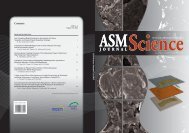Download - Akademi Sains Malaysia
Download - Akademi Sains Malaysia
Download - Akademi Sains Malaysia
You also want an ePaper? Increase the reach of your titles
YUMPU automatically turns print PDFs into web optimized ePapers that Google loves.
Journal of Science and Technology in the Tropics (2010) 6: 59-65<br />
Prompt gamma neutron activation analysis (PGNAA) of hydrocarbons:<br />
A Monte Carlo study with GEANT4<br />
Lam YiHua1 , Wong Chiow San1 * and Kurunathan Ratnavelu2 1Plasma Research Laboratory, Department of Physics, Faculty of Science, University of Malaya,<br />
50603 Kuala Lumpur, <strong>Malaysia</strong><br />
2Institute of Mathematical Sciences, University of Malaya, 50603 Kuala Lumpur, <strong>Malaysia</strong><br />
*Corresponding author<br />
Abstract In the present work, the results of prompt gamma (γ) neutron activation analysis (PGNAA)<br />
calculated by the open source GEANT4 Monte Carlo toolkit were compared with the commercial simulation<br />
package MCNP. Both the Monte Carlo simulation packages utilize the phenomenological nuclear reactions<br />
to yield γ rays which are coupled with incident neutrons after these reactions. A virtual experimental setup<br />
with a 4π solid-angle γ detection was instantiated in the simulations to collect all prompt γ rays from the<br />
tested hydrocarbon phantoms. The comparative results present good agreement in getting the characteristic<br />
γ energy spectra of hydrocarbon materials.<br />
Keywords GEANT4 – MCNP – Monte Carlo simulations – prompt gamma neutron activation<br />
INTRODUCTION<br />
A material with its specific chemical composition and<br />
density can be detected or differentiated from among<br />
other types of materials, which have nearly the same<br />
chemical composition but have not complied with the<br />
same densities, by using prompt gamma (γ) neutron<br />
activation analysis (PGNAA) method. It has been<br />
used in detecting explosive hydrocarbon material [1].<br />
In addition, certain element in a bulk material or in a<br />
biological tissue can be determined via PGNAA, e.g.<br />
biomedical protein detection [2].<br />
PGNAA method relies on neutron-nuclear<br />
interactions, that is, inelastic scattering (n, n′γ), (n, pγ)<br />
and radiative capture (n,γ), to yield γ rays. Although<br />
1/v law [3] (v is the incident neutron velocity) is not<br />
applicable to every element, isotope and energy range<br />
[4], it is still acceptable to be applied in low Z element<br />
and in thermal energy range [5]. This law infers that<br />
the probability of neutron radiative capture depends<br />
on how long the period of time a neutron spends in<br />
the region surrounding the nucleus. The longer period<br />
of time it spends, the higher probability of neutron<br />
radiative capture will occur. Hence, when a low<br />
kinetic energy incident neutron, e.g. thermal neutron<br />
(~0.025eV) or epithermal neutron (0.1-1eV), enters the<br />
narrow separation virtual energy levels in compound<br />
nucleus or interacts with compound nucleus [6], the<br />
neutron radiative capture cross sections will increase.<br />
These low energy interactions raise the possibility of<br />
producing stable isotopes and the coupled γ ray, e.g.<br />
1 H(n, γ) 2 H in which 2 H is a stable isotope and γ ray will<br />
be radiated. Besides, different materials composed by<br />
different chemical compositions (including different<br />
isotopes) and densities will have different radiative<br />
capture cross sections. By radiating low energy<br />
neutrons with certain range of energy distribution on<br />
different materials, the produced γ ray energy spectra<br />
will be different. Hence, the prompt γ ray energy<br />
spectra become an identifying characteristic of the<br />
material.<br />
Other than experimental measurements, PGNAA<br />
can be simulated by using various types of Monte<br />
Carlo computational simulation packages, such as<br />
GEANT4 [7,8], MCNP [9] and FLUKA [10,11].<br />
Most of these packages are written in structural<br />
programming language (C and FORTRAN). GEANT<br />
4 has been written in object-oriented programming<br />
(OOP) architecture (C++), developed and maintained<br />
by many laboratories [7,8]. Conceptually, OOP has<br />
its distinctive feature in treating particle as a single<br />
object which may have encapsulated its own data<br />
Jostt vol 6.indd 59 7/22/10 10:09:51 PM<br />
59

















